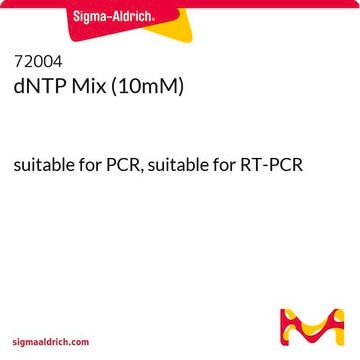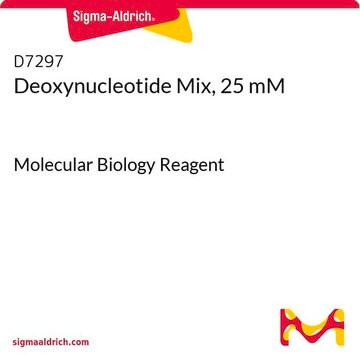D7295
Deoxynucleotide Mix, 10 mM
Molecular Biology Reagent
Synonym(s):
Deoxynucleotide Mix, 10 mM, 10mM dNTP mix, dNTP mix, dNTPs
About This Item
Recommended Products
Quality Level
form
liquid
concentration
10 mM
color
colorless
application(s)
agriculture
foreign activity
DNase, RNase, none detected
shipped in
dry ice
storage temp.
−20°C
Looking for similar products? Visit Product Comparison Guide
General description
Application
- in the PCR amplification of genomic DNA isolated from insect, fungi, virus, human,
- in reverse transcription of total RNA to cDNA.
- as a component of the DNA amplification mixture for polymerase chain reaction (PCR)
- routine and long PCR
- manual and automated DNA sequencing
- cDNA synthesis and labeling reactions
Features and Benefits
- Purity of each dNTP: Minimum 99%
- Conveniently formulated; 1 μL is used per 50 μL PCR
- Equimolar amounts of each dNTP means less pipetting
- Minimize risk of contamination in PCR
- UltraPure dNTPs can help maximize consistency and yields in critical PCR reactions
Storage Class Code
12 - Non Combustible Liquids
WGK
WGK 2
Flash Point(F)
Not applicable
Flash Point(C)
Not applicable
Certificates of Analysis (COA)
Search for Certificates of Analysis (COA) by entering the products Lot/Batch Number. Lot and Batch Numbers can be found on a product’s label following the words ‘Lot’ or ‘Batch’.
Already Own This Product?
Find documentation for the products that you have recently purchased in the Document Library.
Customers Also Viewed
Protocols
Protocol for high fidelity amplification of long PCR fragments up to 22kb from complex DNA mixtures and up to 40kb from simple DNA mixtures. AccuTaq LA.
Method for amplification of DNA from damaged DNA sources. Particularly useful for DNA extracted from old samples.
Method for amplification of DNA from damaged DNA sources. Particularly useful for DNA extracted from old samples.
Method for amplification of DNA from damaged DNA sources. Particularly useful for DNA extracted from old samples.
Our team of scientists has experience in all areas of research including Life Science, Material Science, Chemical Synthesis, Chromatography, Analytical and many others.
Contact Technical Service













